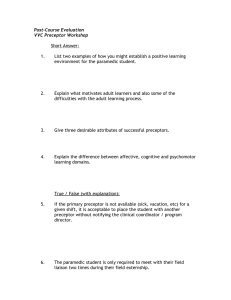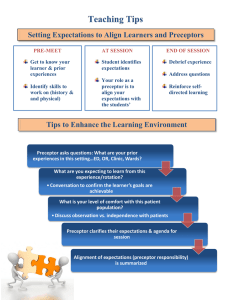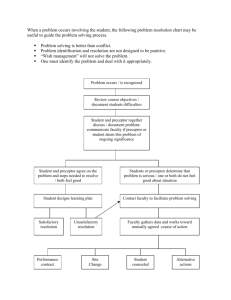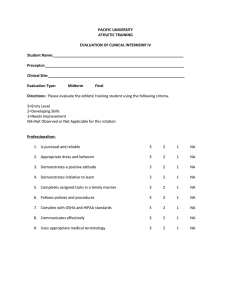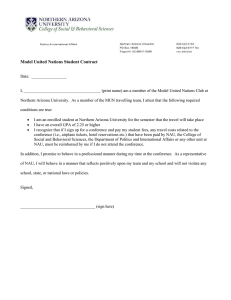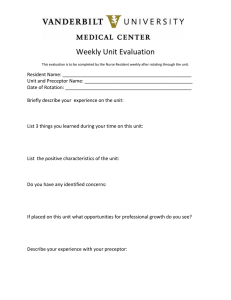AT 401
advertisement
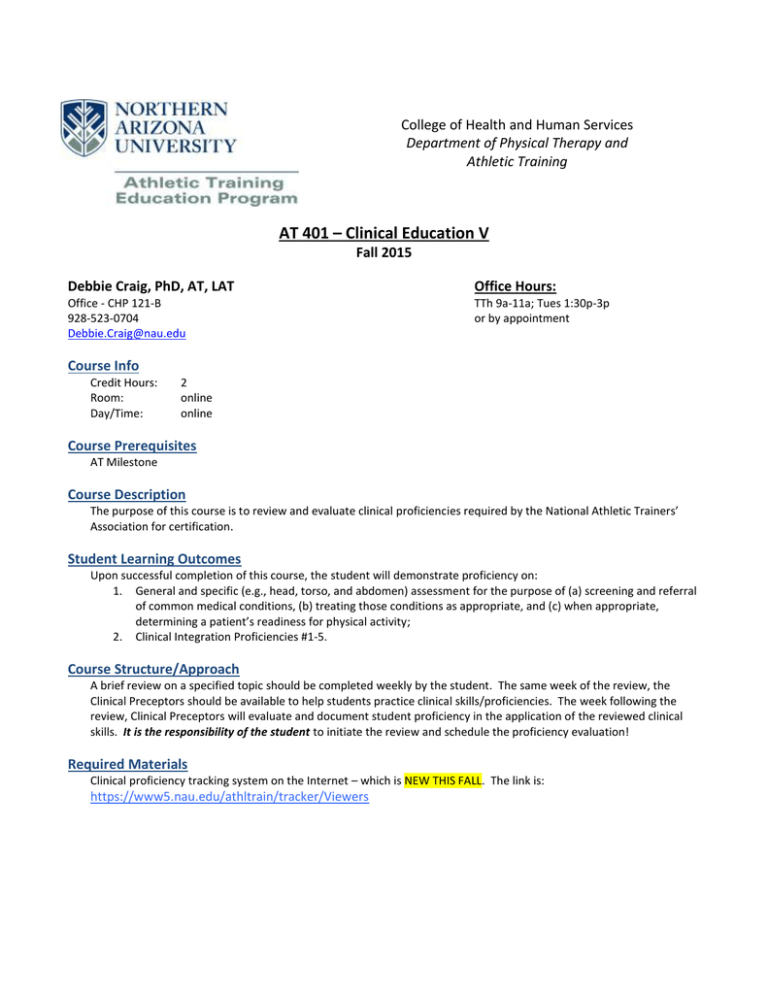
College of Health and Human Services Department of Physical Therapy and Athletic Training AT 401 – Clinical Education V Fall 2015 Debbie Craig, PhD, AT, LAT Office Hours: Office - CHP 121-B 928-523-0704 Debbie.Craig@nau.edu TTh 9a-11a; Tues 1:30p-3p or by appointment Course Info Credit Hours: Room: Day/Time: 2 online online Course Prerequisites AT Milestone Course Description The purpose of this course is to review and evaluate clinical proficiencies required by the National Athletic Trainers’ Association for certification. Student Learning Outcomes Upon successful completion of this course, the student will demonstrate proficiency on: 1. General and specific (e.g., head, torso, and abdomen) assessment for the purpose of (a) screening and referral of common medical conditions, (b) treating those conditions as appropriate, and (c) when appropriate, determining a patient’s readiness for physical activity; 2. Clinical Integration Proficiencies #1-5. Course Structure/Approach A brief review on a specified topic should be completed weekly by the student. The same week of the review, the Clinical Preceptors should be available to help students practice clinical skills/proficiencies. The week following the review, Clinical Preceptors will evaluate and document student proficiency in the application of the reviewed clinical skills. It is the responsibility of the student to initiate the review and schedule the proficiency evaluation! Required Materials Clinical proficiency tracking system on the Internet – which is NEW THIS FALL. The link is: https://www5.nau.edu/athltrain/tracker/Viewers Course Outline 401A - Derma Lesions/Skin Conditions 401B - Gen Med - Face/Eyes/Teeth/Nose/Mouth/Ears 401C - Gen Med: Thorax/Abdomen 401D - Vital Sign Assessment and Management 401E - General Medical Disease Management 401F - CIP-1. Administer testing procedures to obtain baseline data regarding a client’s/patient’s level of general health (including nutritional habits, physical activity status, and body composition). Use this data to design, implement, evaluate, and modify a program specific to the performance and health goals of the patient. This will include instructing the patient in the proper performance of the activities, recognizing the warning signs and symptoms of potential injuries and illnesses that may occur, and explaining the role of exercise in maintaining overall health and the prevention of diseases. Incorporate contemporary behavioral change theory when educating clients/patients and associated individuals to effect health-related change. Refer to other medical and health professionals when appropriate. 401G - CIP-2. Select, apply, evaluate, and modify appropriate standard protective equipment, taping, wrapping, bracing, padding, and other custom devices for the client/patient in order to prevent and/or minimize the risk of injury to the head, torso, spine, and extremities for safe participation in sport or other physical activity. 401H - CIP-3. Develop, implement, and monitor prevention strategies for at-risk individuals (eg, persons with asthma or diabetes, persons with a previous history of heat illness, persons with sickle cell trait) and large groups to allow safe physical activity in a variety of conditions. This includes obtaining and interpreting data related to potentially hazardous environmental conditions, monitoring body functions (eg, blood glucose, peak expiratory flow, hydration status), and making the appropriate recommendations for individual safety and activity status. 401I - CIP-4. Perform a comprehensive clinical examination of a patient with an upper extremity, lower extremity, head, neck, thorax, and/or spine injury or condition. This exam should incorporate clinical reasoning in the selection of assessment procedures and interpretation of findings in order to formulate a differential diagnosis and/or diagnosis; determine underlying impairments; and identify activity limitations and participation restrictions. Based on the assessment data and consideration of the patient’s goals, provide the appropriate initial care and establish overall treatment goals. Create and implement a therapeutic intervention that targets these treatment goals to include, as appropriate, therapeutic modalities, medications (with physician involvement as necessary), and rehabilitative techniques and procedures. Integrate and interpret various forms of standardized documentation including both patient-oriented and clinician-oriented outcomes measures to recommend activity level, make return to play decisions, and maximize patient outcomes and progress in the treatment plan. 401J - CIP-5. Perform a comprehensive clinical examination of a patient with a common illness/condition that includes appropriate clinical reasoning in the selection of assessment procedures and interpretation of history and physical examination findings in order to formulate a differential diagnosis and/or diagnosis. Based on the history, physical examination, and patient goals, implement the appropriate treatment strategy to include medications (with physician involvement as necessary). Determine whether patient referral is needed, and identify potential restrictions in activities and participation. Formulate and communicate the appropriate return to activity protocol. Evaluation Methods and Deadlines Reflective Journaling Reflective journaling will be required as weekly assignments. Students are to complete one reflective journal per week. Journal entries are due every Monday by 5pm. They will be submitted through Blackboard course email. They will be kept confidential and feedback will be given. These entries are meant to be reflective in nature to stimulate critical thinking processes regarding the integration of classroom skills with clinical practice. Additionally, please record your daily clinical hours for the previous week at the end of your journal entry, to give the instructor an idea of time spent in correlation with your learning. Students may not miss or turn in late any journal entries. Missing or being tardy with 2 or more journal entries will result in a failing grade for the course. Evaluation Deadlines Pre-Semester - 9/7 by 8pm Mid-Semester – 10/21 by 8pm End of Semester – 12/11 by 8p Grading System This course will be graded PASS/ FAIL. To pass the course, students must: 1. Be evaluated as “Proficient” for all skills listed above by December 1, 2015; 2. Turn in completed Clinical Preceptor goal setting, mid-semester, and final semester evaluation of AT Student evals online (total of 3 evals due); 3. Receive positive scores on each Clinical Preceptor evaluation. 4. Complete weekly journal postings by the Monday 5pm deadline. All proficiencies, evaluations, and journal submissions must be completed before December 7, 2015. Failure to do so will result in a FAILING grade. Course Policy Retest/makeup tests Students will only be evaluated on that week or future week skill. Skills discussed in previous weeks will be evaluated or re-evaluated by their assigned Clinical Preceptor. Students MUST be proficient in all skills listed, by Dec.1st . No testing or re-testing of skills will be accepted after that date. Attendance Clinical site attendance is mandatory. Specific schedules are to be arranged by the Clinical Preceptor and the student but should not exceed 30 hours per week (20 hours if serving Probation). In the event of an emergency absence the student is required to contact the Clinical Preceptor as soon as possible. If a situation occurs where you cannot be at your clinical site for a scheduled time, you must notify the Clinical Preceptor with at least 24 hours notice, or the absence will not be excused. Statement on plagiarism and cheating See University policies, at: http://www4.nau.edu/avpaa/policy1.html Withdrawal Policy The university course drop deadline is September 9, 2015. The university course withdrawal deadline is October 30, 2015. It is the policy of the College of Health and Human Services that petitions to withdraw after November 15, 2015, will not be considered. University Policies Visit the Universities website regarding Safe Working and Learning Environment, Students with Disabilities, Institutional Review Board, and Academic Integrity, at: http://www4.nau.edu/avpaa/policy1.html Emergency Textbook Loan Program: To help students acquire the materials they need to be successful in class. NAU has partnered with Follett to create the Emergency Textbook Loan program. The program is administered by the LEADS Center. The program assists students with unmet financial need in obtaining required textbook(s) and other materials for courses. Students must apply and meet eligibility criteria before textbooks are purchased on their behalf. Textbooks must be returned at the end of the term in which the textbooks were loaned. More information can be found online: http://nau.edu/LEADS-Center/Textbook-Loan-Program/
